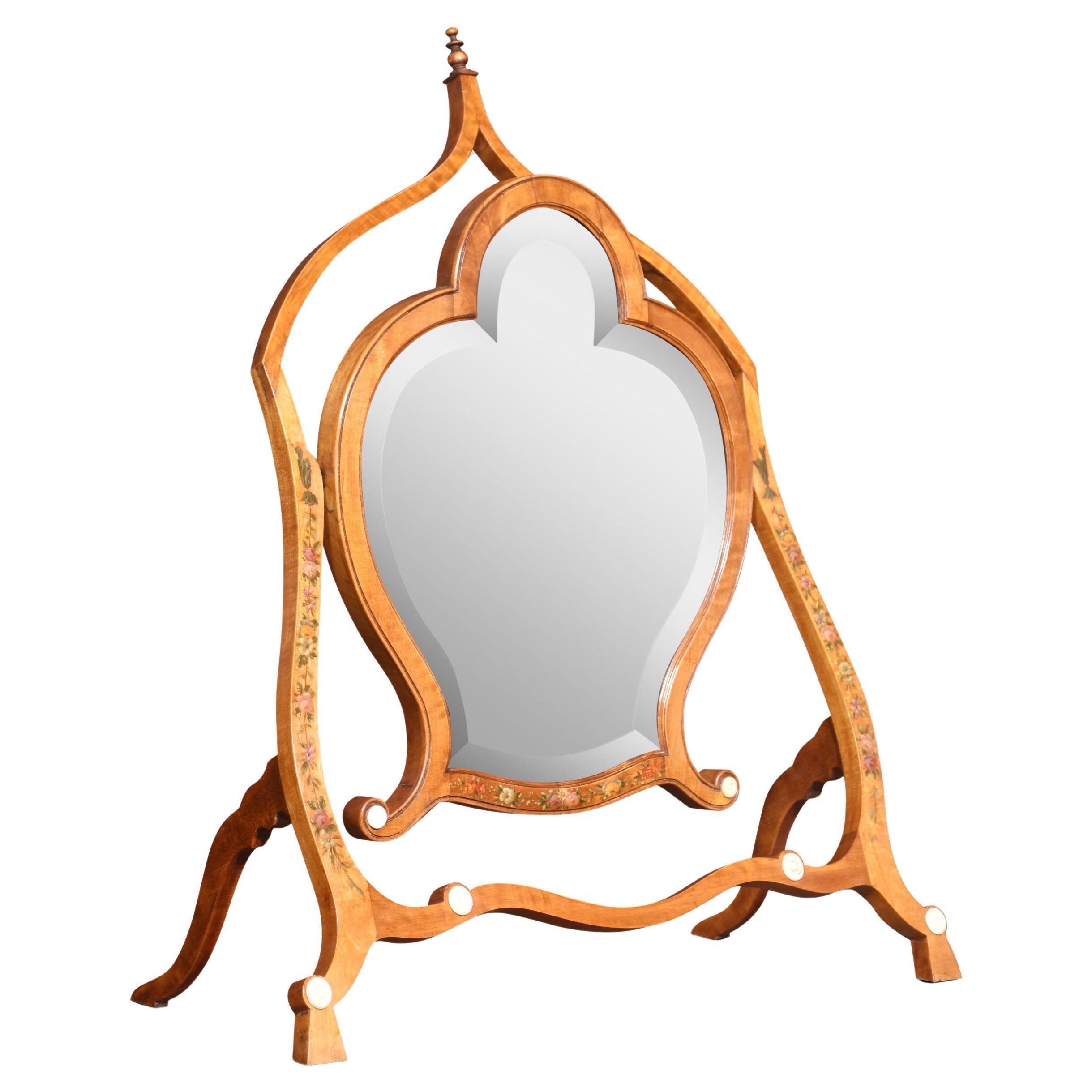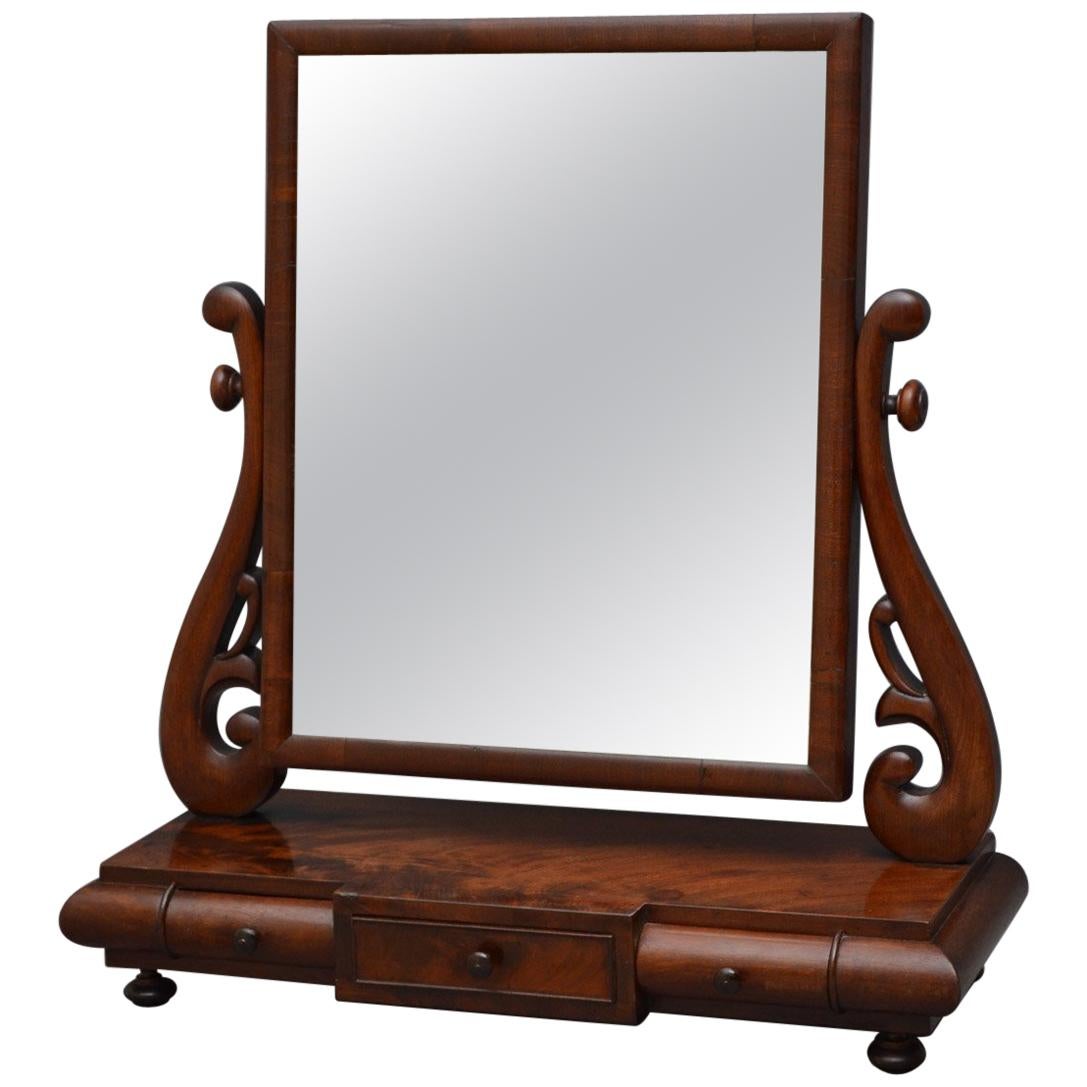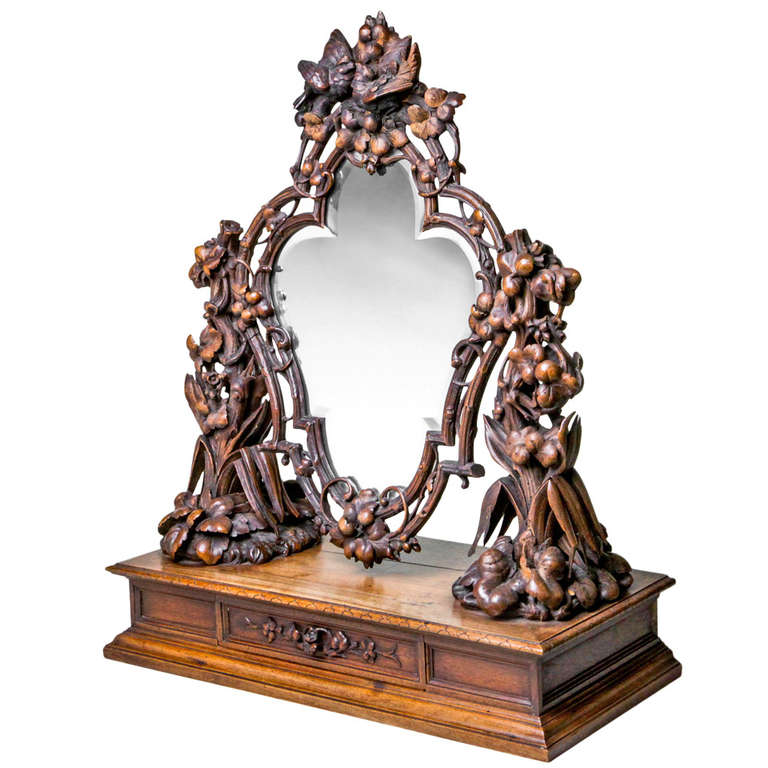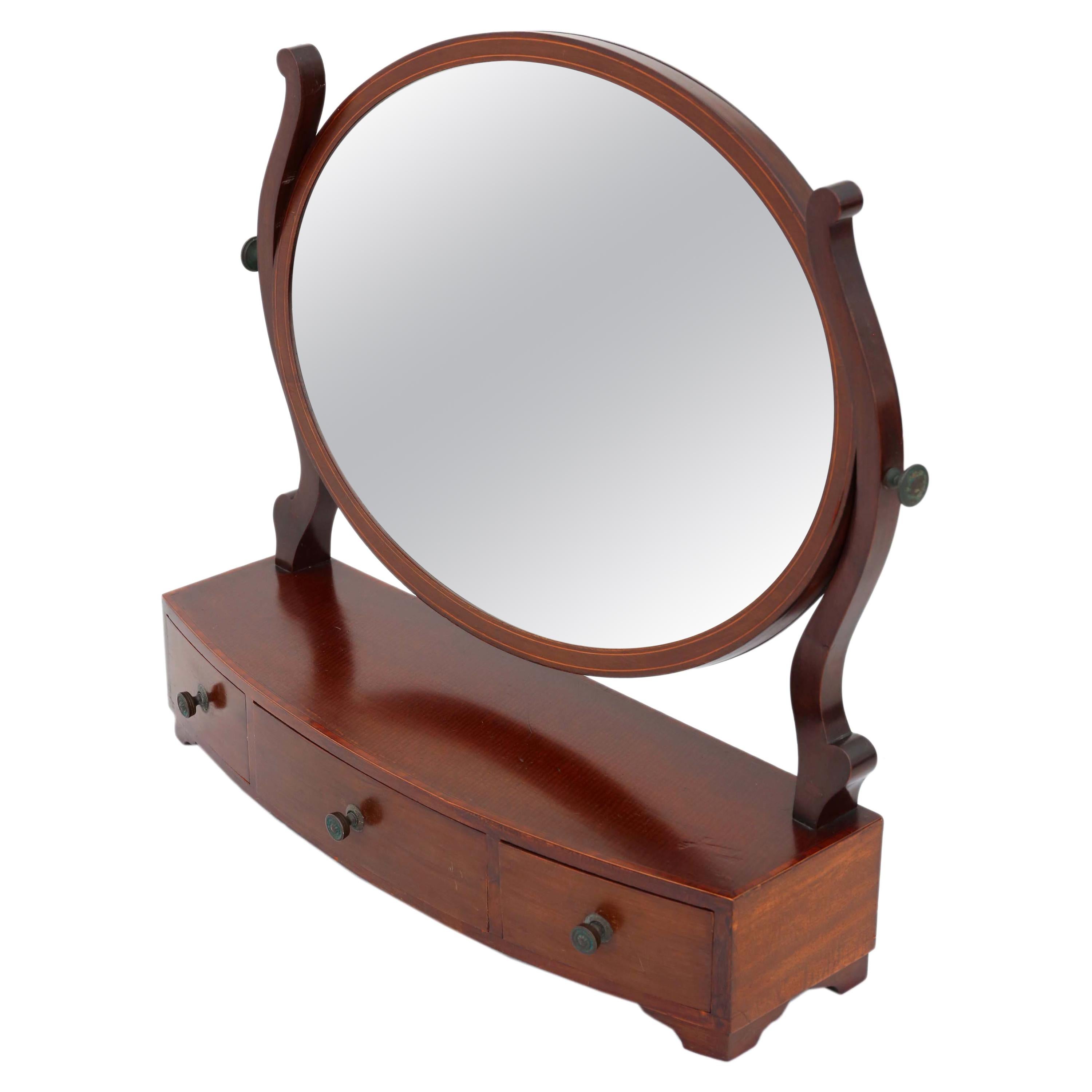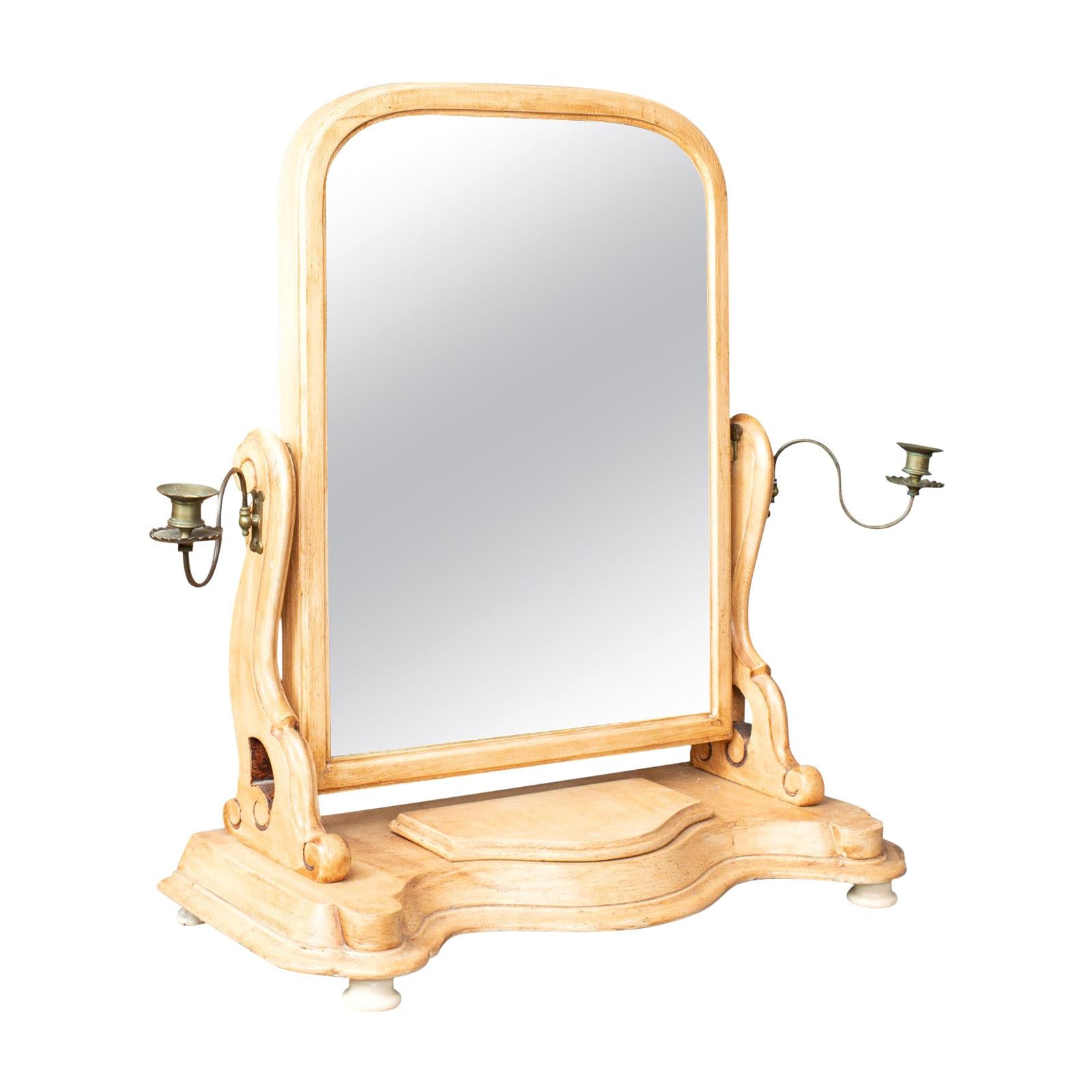Items Similar to William & Mary Japanned Painted Dressing Table Mirror
Video Loading
Want more images or videos?
Request additional images or videos from the seller
1 of 7
William & Mary Japanned Painted Dressing Table Mirror
About the Item
An extremely rare dressing table mirror of the William and Mary period, ca 1690.
English, late 17th century, japanned and painted dressing table mirror (remarkable to survive in its original state), retaining its floral decoration throughout.
The fall front reveals a concave, fitted, stepped interior of drawers and pigeon holes. A conforming long drawer beneath the fall has six compartments, one of which conceals a secret recess.
All fully poly-chrome painted in the manner of the 17th-century Netherlandish flower painting school.
A fine and rare museum-quality piece of unusually large scale. This antique may well be unique.
Nb. Also referred to as a ''toilet mirror'' or ''vanity''.
Nnb. Sometimes japanning is confused with lacquer, but this piece is japanned.
Measures:
W 18” (46.5 cm)
H 34” (86 cm)
D 10” (26 cm).
Literature & refs:
An important flower-painted lacquer cabinet sold Sotheby’s, New York, 21st October 2000, lot 294.
Viz. Leverhulme sale, 26-28 June 2001, lot 220.
Viz. Sotheby's sale of the estate of Lady Hesketh, Easton Neston, London, 7th March 2007, lot 25.
Viz. Wikipedia: William and Mary.
- Dimensions:Height: 33.86 in (86 cm)Width: 18.31 in (46.5 cm)Depth: 10.24 in (26 cm)
- Style:William and Mary (Of the Period)
- Materials and Techniques:
- Place of Origin:
- Period:
- Date of Manufacture:1690
- Condition:Wear consistent with age and use. Unrestored, original condition.
- Seller Location:Lymington, GB
- Reference Number:
About the Seller
5.0
Vetted Seller
These experienced sellers undergo a comprehensive evaluation by our team of in-house experts.
Established in 1957
1stDibs seller since 2018
33 sales on 1stDibs
Typical response time: 8 hours
- ShippingRetrieving quote...Ships From: Lymington, United Kingdom
- Return PolicyA return for this item may be initiated within 14 days of delivery.
More From This SellerView All
- Very Rare Carved Gilt Gesso Dressing Mirror, circa 1710-1720Located in Lymington, GBA very rare carved gilt gesso dressing mirror. Queen Anne / George I period, c 1710-20. Decorated all over with the original finely carved gilt-gesso surfaces with typical circular punched reserves. The hinged fall reveals a shaped, fitted interior, gilded and japanned (lacquered) in red. Some external carved surfaces show very minor areas of wear revealing the authentic bole and gesso ground. Overall in superb condition. Measures: H: 39 1/2’’ (100 cm) D: 12 1/2’’ (31.5 cm) W: 17 3/4’’ (45.5 cm). Reminiscent of the work of London-based James Moore (c 1670-1726), a supreme exponent of the art of cut gesso and gilding. This dressing table mirror is possibly unique in this form, and as such has survived over 300 years in remarkably original state. It may have been part of a suite of furniture, would have been extremely costly, and very much the reserve of the aristocracy and the wealthy in the early part of the 18th century. For documented pieces by James Moore viz. The Royal Collection Trust Wikipedia - James Moore (furniture designer) James Moore (circa 1670 - October 1726) was established at Short's Gardens, St. Giles-in-the-Fields. He was in partnership with John Gumley from 1714 and, unlike his partner, did not advertise - the sole published reference to him being a notice of his death in The Weekly Journal or The British Gazetteer. As Royal cabinet-maker he supplied walnut and mahogany furniture for the Royal Household, The Royal Yacht, and the King's servants and mistresses, as well as the rich gilt-gesso work for which he is best known. Moore is especially renowned for gilt-gesso furniture: tables; looking glass frames; and candle stands. A pair of gilt-gesso side tables bearing the crowned cypher of George I in The Royal Collection, and the pair of candle stands en-suite are incised with his name - an unusual practice at the time. At Erddig, such furniture by Moore can be linked to surviving bills and receipts from James Moore and John Belchier, 1722-26. Gilt-gesso furniture is also encountered in fine Louis XlV and other European furniture of the period. Literature: Ralph Edwards CBE FSA ’The Shorter Dictionary of English Furniture’ Hamlyn, London (Fourth Impression 1972) ill. 5, p. 363. One of a pair of looking glasses by James Moore, 1720. Erddig, Denbigh. The crest is reminiscent of that upon our dressing mirror, which we are offering here. Kreisel, Heinrich, 'Die Kunst Des Deutschen Mobels’ CH Beck, Munchen (1970) ill. 345, p. 347 - note similarities in the treatment of the top of the crest. This mirror was last seen in the collection of Augsburg Castle. Synge, Lanto, 'Great English Furniture' London (1991) p. 52. Refs: Symonds, R. W. 'A Royal Scrutoire', Connoisseur (June 1940) pp. 233-236. Symonds, R. W. ‘English Gesso Furniture’, The Antique Collector, Vol. XXVII (August 1956) p. 140. ‘A Golden Cabinet...Category
Antique Early 18th Century Queen Anne Table Mirrors
MaterialsGiltwood
- William & Mary Period Oyster Laburnum and Walnut ChestLocated in Lymington, GBAn English William & Mary period oyster laburnum and walnut chest ca 1700. William lll (1650-1702). A classic oyster-veneered chest of two short and three long graduated drawers all faced with exquisite oyster veneers banded in fruitwood. The top with well-chosen oyster inlays...Category
Antique Early 18th Century English William and Mary Commodes and Chests ...
MaterialsWalnut
- William and Mary Walnut Double Dome Bureau Bookcase or CabinetLocated in Lymington, GBA rare William & Mary period walnut double-dome bureau bookcase / cabinet. Circa 1685. Of compact size and proportions. In excellent overall condition with old, waxed, well-patinated surfaces of very good color. This bureau bookcase, or cabinet, divides into three separate sections (which helps date it to the last quarter of the 17th century). The bold double-dome pediment and cross-grain mouldings are typical of this period, and are repeated in the side returns. The book-matched, hand-cut veneers are well figured throughout, and are contained within herringbone lines. The bookcase section has candle slides, contains shelves and fitted drawers. Gilded finials are later. The centre section with a quarter-veneered fall reveals a fitted interior, concealed well and a secret compartment. The writing section is raised on a three-drawer base with an unusual and boldly-arcaded apron, in turn raised on its apparently original walnut bun feet. The drawer dividers are faced with cross-grain walnut ‘D’ mouldings. The brass engraved mounts are correct for period but not original, however the locks and hinges are. It is unusual to encounter these early bookcases / cabinets constructed in three stages; an indication of a transition taking place from the 17th into the 18th century. This is a fine, rare and sophisticated piece of late-17th century walnut furniture...Category
Antique 17th Century English William and Mary Cabinets
MaterialsWalnut
- George III Serpentine Inlaid Writing Dressing TableBy Pierre LangloisLocated in Lymington, GBA George III period sabicu and goncalo alves serpentine writing / dressing table. In the manner of master cabinet-maker Pierre Langlois, circa 1770. Gr...Category
Antique 1770s English Tables
MaterialsWood
- Small 18th Century Walnut Lowboy Dressing Table VanityLocated in Lymington, GBA compact-sized 18th-century walnut lowboy / dressing table / vanity. George II period, circa 1750. Raised on cabriole legs, this small English walnut table is only 2' 5'' wide. Ret...Category
Antique 1790s English George II Lowboys
MaterialsWalnut
- Large English Regency Chinoiserie Japanned Tôle Tray TableLocated in Lymington, GBA large English chinoiserie japanned tôle (tole) tray table. Regency period, early 19th century, circa 1810. The gilt-heightened exotic landscape set on a Venetian-red ground. Depicting a watery seascape amongst pagodas, pavilions, rockwork, trees, and a courtly lady beside a bridge, all raised on its apparently original open-fretted Oriental stand...Category
Antique 1810s English Regency Side Tables
MaterialsWood
You May Also Like
- Satinwood painted dressing mirrorLocated in Cheshire, GBSatinwood dressing mirror the urn finial above shaped frame with floral painted detail, supporting the original mirror plate. All raised up on splayed legs. Dimensions Height 29 Inch...Category
Early 20th Century British Table Mirrors
MaterialsSatinwood
- Stylish William IV Dressing Mirror in MahoganyLocated in Whaley Bridge, GBK093 Stylish William IV, mahogany dressing table mirror, having original mirror plate in rectangular frame with finely carved supports terminating in breakfronted, flamed mahogany ba...Category
Antique 1830s English William IV Table Mirrors
MaterialsMahogany
- Bavarian Dressing Table MirrorLocated in New York, NYCarved hardwood Bavarian dressing table mirror. Designed with a scalloped shaped mirror supported by a woodland theme frame. Superbly carved fram...Category
20th Century German Table Mirrors
- Dressing, Table, Swing, MirrorLocated in Wisbech, CambridgeshireAntique fine quality dressing table swing mirror toilet circa 1880. Far better quality than most. A rare find with glorious ray cut mahogany veneers. The ...Category
Antique 1880s Table Mirrors
MaterialsGlass
- Mahogany Dressing Table MirrorLocated in Cheshire, GBMahogany shaving/dressing table mirror, with adjustable circular mirror within moulded carved surround over lobed baluster upright, on a circular...Category
Early 20th Century British Table Mirrors
MaterialsWood
- Antique Dressing Table Mirror, English Victorian, Vanity, Toilet, PaintedLocated in Hele, Devon, GBThis is an antique dressing table mirror, an English, Victorian, vanity toilet mirror with a later painted finish dating to the late 19th...Category
Antique Late 19th Century English Victorian Table Mirrors
MaterialsMahogany
Recently Viewed
View AllMore Ways To Browse
Antique Sale
Sale Antique
Antique Lots
Antique Lot
Antique Painted Hall Table
Antique Furniture Lot
Large Painted Table
Furniture Dressing Table
Antique Table Mirror Mirrors
Antique Table Mirrors
Antique Mirror Table
Antique Mirror Tables
Antique Mirrored Table
Wood Table With Mirror
Antique Mirror And Table
Antique Table And Mirror
Marys Used Furniture
Antique Table With Mirror
